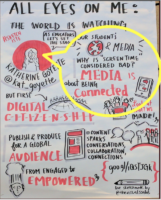
Empower Students Using Media
As an Educational Technology Consultant for Tulare County Office of Education in California, I am always seeking out new ways to empower students to think critically and communicate their learnings in a way that builds upon the context of the modern world in which they live. Students are constantly using Social Media to connect with their peers and reflect upon their lives. Media is about being connected. Leveraging social media in the classroom allows us to not only meet students in a format in which they are familiar, it’s interactive format fosters collaborative conversations based on content. This blog chronicles my personal journey with #BookSnaps, which serendipitously led to #BookSmashing, a method for students to conduct comparative analysis of separate texts. #BookSnaps led me to #BookSmash serendipity!

While I call the experience serendipitous, it is actually a natural affect of the creative process. We learn by doing, by experimenting with new formats of expressing our ideas, by making connections as we process content within the context of prior learnings. As we open our mind to options that differ from that which we have always done, innovation occurs.
My Personal #BookSnaps Journey

In reading Launch: Using Design Thinking to Boost Creativity and Bring Out the Maker in Every Student by John Spencer and A.J. Juliani, I challenged myself to take notes of my reflections by creating #BookSnaps. I had learned about #BookSnaps on Dave Burgess’ blog featuring #BookSnap creator Tara Martin. I downloaded SnapChat and began experimenting with this app which is so familiar to students but was so foreign to me. My first #BookSnap was certainly not my best. But the content of the #BookSnap focused on creativity. This drove me to continue using #BookSnaps as a creative method of close reading, annotating, making connections, and documenting my learning.
Power of Publishing
While I have long spoke of the power of an authentic audience to increase student motivation, my own experience posting my first #BookSnap on Twitter demonstrated how publishing can also lead to connections. I was thrilled to receive a response from A.J. Juliani, one of the authors from the book I was referring in my #BookSnap! In my response to A.J., I made a connection to a quote from George Couros “Isolation is a choice that educators make”. Little did I realize that this connection would soon lead to an iteration of #BookSnaps: the #BookSmash!
The Birth of the #BookSmash
In continuing to read #LaunchBook by John Spencer and A.J. Juliani, I continued to recognize parallels to a prior reading, Innovator’s Mindset by George Couros. The connections between the two texts was so pronounced that I created a #BookSnap from #LaunchBook, with a direct quote from Innovator’s Mindset. The #BookSnap itself reveals my amateur skills with SnapChat, yet the connection between texts is clear. As a reader, I made a connection between two texts, and documented this comparative close reading activity via a #BookSnap. I termed this format of documenting comparative textual analysis: #BookSmash.

Research reveals that the brain best sustains new learning when it is connected to the context of prior learnings. The #BookSmash encourages students to connect text to this prior learning, to engage learners in comparative textual analysis in a social media format with which they are accustomed. I encourage ALL educators to explore #BookSnaps, and to consider leveling-up to the #BookSmash. Even better, let’s empower our students to create connections between texts using the #BookSmash. And once the textual connections have been made, leverage the power of publishing by documenting student work for an interactive, authentic audience.
